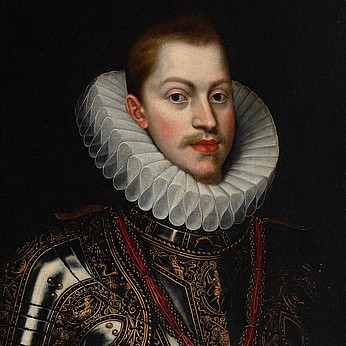Flemish school; early seventeenth century. "St. Hermenegildo". Oil on canvas.
Lot 54
About Seller
Setdart Auction House
Carrer Aragó 346
Barcelona
Spain
Setdart Subastas was born in 2004 and is currently the first online art auction in Spain with solidity, prestige and reliability guaranteed by our more than 60,000 users. Setdart has a young, dynamic and enterprising team ready to successfully manage the purchase and sale of art works through custom...Read more
Estimate:
EUR€4,000 - EUR€5,000
$4,301.08 - $5,376.34
Absentee vs Live bid
Two ways to bid:
- Leave a max absentee bid and the platform will bid on your behalf up to your maximum bid during the live auction.
- Bid live during the auction and your bids will be submitted real-time to the auctioneer.
Bid Increments
| Price | Bid Increment |
|---|---|
| EUR€0 | EUR€10 |
| EUR€200 | EUR€25 |
| EUR€500 | EUR€50 |
| EUR€1,000 | EUR€100 |
| EUR€3,000 | EUR€200 |
| EUR€5,000 | EUR€500 |
| EUR€10,000 | EUR€1,000 |
| EUR€20,000 | EUR€2,000 |
| EUR€50,000 | EUR€5,000 |
About Auction
By Setdart Auction House
Nov 24, 2021
Set Reminder
2021-11-24 09:00:00
2021-11-24 09:00:00
America/New_York
Bidsquare
Bidsquare : Old Masters, Day 1
https://www.bidsquare.com/auctions/setdart-auction-house/old-masters-day-1-7873
Setdart Auction House sofia@setdart.com
Setdart Auction House sofia@setdart.com
- Lot Description
Flemish school; early seventeenth century. "St. Hermenegildo". Oil on canvas. Measurements: 104 x 125 cm. San Hermenegildo, was son of the Visigoth king Leovigildo. In the year 579 he confronted his father and married Ingund, the daughter of the Frankish king Sigebert I of Austrasia, who was a Christian. Later he started a rebellion, in which he tried to replace Arianism with Christianity. During the strife Hermenegild fled to Seville and when it fell to a siege in 584, he made his way to Cordoba. After Leovigild paid 30,000 gold pieces, the Byzantines withdrew and took Ingund, his wife and son with them. Hermenegild sought refuge in a church and his father sent Recaredo, Hermenegild's brother, to offer peace. In this scene the author presents us with the saint on his knees, praying and moving his face towards the crucifix that is placed on the tree on the left side of the composition. However, in spite of the pious theme of the scene, the multitude of animals that share the composition with St. Hermenegild is striking: a white horse, from which he seems to have gotten off immediately since he is saddled, three dogs located in the lower part of the foreground and a deer standing on a promontory, looking directly at the saint. This feature creates a confusing situation in the conception of the work, since it seems that San Hermenegildo also looks at the animal, losing in a certain way the presence of the deer. It is a painting belonging to the Flemish school, which is intuited due to some characteristics ascribed to that school. In this one, there is a realistic reaction against the fantasy of the international gothic, it is a painting very influenced by the art of sculpture, oil painting is usually generalized, it is a painting with a great symbolic sense that allows us two readings, the symbolic and the realistic. There is importance for detail, with a meticulous description of objects, nothing escapes the eye of the painter, the presence of many details is evident, a painting in which real beings appear without idealistic intention. The portrait occupies an increasingly prominent place, there is a greater study of light, also veracity of the sense of volume, depth is sought in space, getting the perspective intuitively.
- Shipping Info
-
In-house shipping available. Please inquire at admin@setdart.com.
-
- Buyer's Premium



 EUR
EUR CAD
CAD AUD
AUD GBP
GBP MXN
MXN HKD
HKD CNY
CNY MYR
MYR SEK
SEK SGD
SGD CHF
CHF THB
THB

















